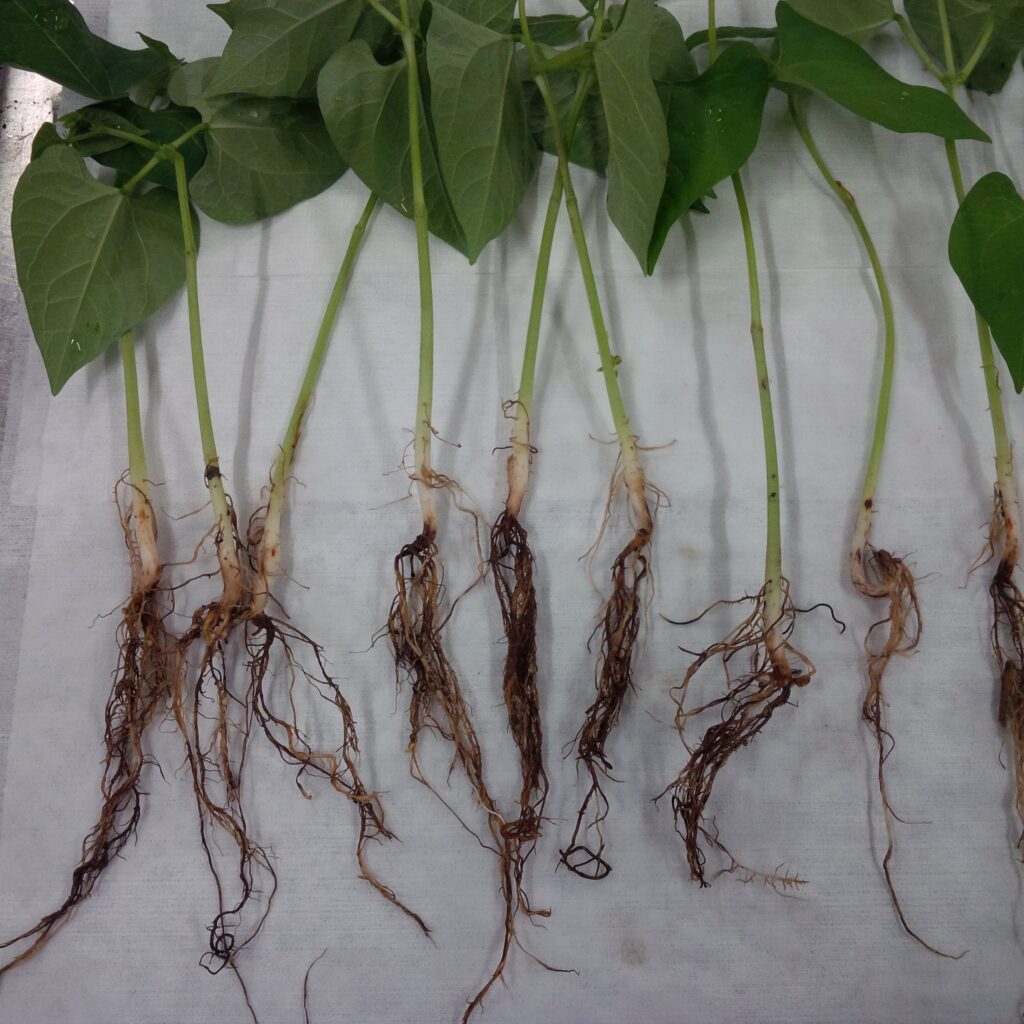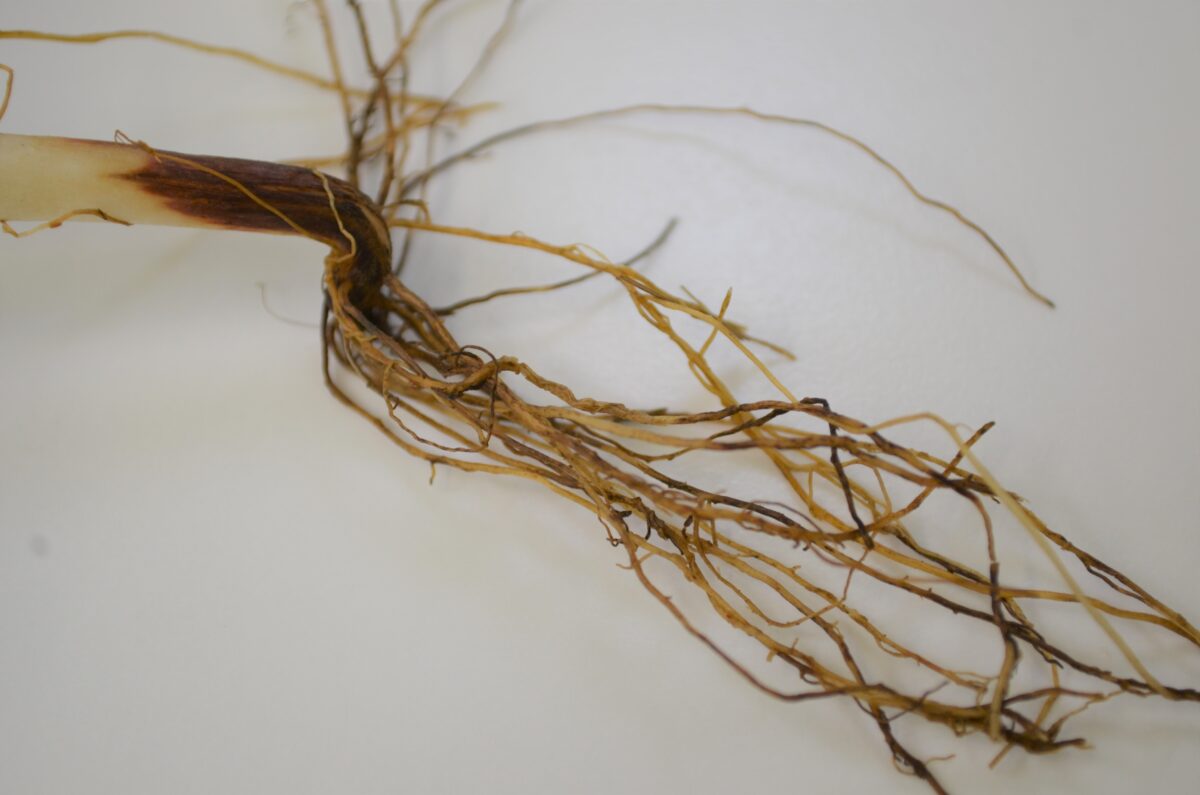Root rot complex (Fusarium solani, Rhizoctonia solani, Pythium spp. , Chalara basicola)
Incidence
Numerous organisms cause root rot symptoms on dry edible beans. In Ontario, the four main fungal pathogens are Fusarium, Pythium, Rhizoctonia and Chalara (formerly Tielaviopsis). These organisms can occur individually or in combination, as is often the case. This is referred to as “root rot complex.” The amount of damage is related to the general health of the crop, field history, cultivar susceptibility and environmental conditions. Compact and poorly drained soils tend to have more root rot. Where other plant health issues are present, such as herbicide carry over, root rot can set in.
Appearance
Symptoms can appear on plants at any stage of development. Early-season infection results in typical pre-emergence (seed decay) and post-emergent (seedling death) “damping-off” symptoms, thereby reducing plant stands or referred to as poor emergence. Plants that survive early infection (damping-off) or become infected later display characteristic “root rot” symptoms such as discoloured roots, stunting, wilting, yellowing of leaves and overall poor growth.
Fusarium, also referred to as “dry root rot” affects all stages of development. Symptoms often appear in fields that were dry and then receive substantial rainfall. It is an adventitious disease that commonly infects bean plants that are already stressed from other causes. Fusarium root rot begins as small, reddish-brown lesions (in the first few weeks) that, as the plant ages, join to form larger lesions or streaks on the taproot surface. A reddish-brown internal discolouration of the water-conducting tissue can be seen by splitting the taproot, crown and lower stem. Adventitious roots may develop on plants that have a damaged taproot. These roots are formed above the damaged area. Late infection seldom results in dead plants but rather in stunted, weak-looking ones. Leaves turn yellow and wilt or drop off, with these symptoms gradually advancing up the plant. When the disease is advanced, leaf margins turn brown and die.
Pythium thrives under wet conditions and is often an early season disease that causes damping-off of seeds and seedlings. Affected seeds and seedlings become mushy and discoloured. Pythium root rot has a characteristic brown, water-soaked (wet) lesion that starts at the base of the taproot. This lesion advances up the root and stem, eventually stopping 2–3 cm (0.8–1.2 in.) above the soil line. Seedlings are often killed, resulting in stand establishment problems. Although older seedlings and mature plants may not die from Pythium infection, their roots are often pruned, resulting in stunted, poorly anchored, wilted and unhealthy looking plants.
Rhizoctonia root rot forms reddish-brown, sunken lesions on the stem and taproot, most frequently near the soil line. The lesion can girdle the entire stem, causing stunting or death of the plant. This lesion is distinctively “brick red” in colour, noticeable immediately after removing the plant from the soil. This is one method of distinguishing rhizoctonia root rot from fusarium root rot. The intensity of the “brick red” colour will fade rapidly with exposure to the air. Lesions become cankerous and are less red with age. Cankers may become rough and dry. The fungus may enter the plant and destroy the pith, resulting in rotting brown tissue within the center of the stem.

Chalara or “black root rot” results in brown-to-black lesions being formed on the taproot and lateral roots. Under severe conditions, the entire taproot may be black.
Disease Cycle
These fungi survive in the soil in plant debris or as mycelium. They are attracted to the sugars and exudates released by the developing roots. They are most problematic when environmental conditions are cool and wet during planting or when these conditions result in a delay in seedling emergence or development. Mid- to late-season moisture stress (dry conditions) will increase the amount of fusarium and rhizoctonia root rots.
Management Strategies
Eliminating these diseases is not possible and once plants are infected there is no good control measure. Yield losses from these diseases can be reduced by the following management practices:
- Select cultivars that have good general tolerance to root rots.
- Promote root growth through good fertility programs. Keep soil organic matter content as high as possible.
- Maintain or build up good soil tilth by following a good crop rotation (3 years between bean crops of any kind), not overworking the soil and avoiding working soil when it is too wet.
- Remove excessive water through increased tile drainage and minimized compaction.
- Apply seed treatments that will help protect the plant from root rots during germination and early growth. Refer to OMAFRA Publication 812, Field Crop Protection Guide, for seed treatment guidelines.
- Inter-row cultivation that hills soil around plant stems may encourage plants to form new root above the rotted taproot, provided adequate moisture exists. Avoid close cultivation to minimize root pruning.
- Application of 40-60 kg/ha (35-50 lbs/ac) of nitrogen may assist in stimulating new root growth. In wide rows, nitrogen can be injected as either anhydrous ammonia or 28%. If nitrogen is to be broadcast, forms other than urea are preferred to mitigate volatilization losses.
- Quick, even emergence in good growing conditions reduces the risk of root rot infection. Plant into warm (above 15°C), moist soils with good drainage. Planting into cool soils or before rain increases the risk of damping off.
- Crop rotations should be 3 to 4 years or longer with non-host crops such as corn, cereals, forage grasses, and alfalfa. Plant residues from soybeans, canola, peas and potatoes host bean root rot organisms.



References
OMAFRA Agronomy Guide for Field Crops – Pub 811, with credit to Albert Tenuta, Field Crop Pathologist
Compendium of Bean Diseases. Edited by Robert Hall, University of Guelph.
Root Rots of Dry Beans, North Carolina State University https://extension.colostate.edu/topic-areas/agriculture/root-rots-of-dry-beans-2-938/
Fusarium Dry Rot of Beans, Cornell University. http://vegetablemdonline.ppath.cornell.edu/factsheets/Beans_Fusarium.htm
